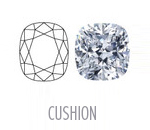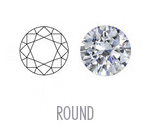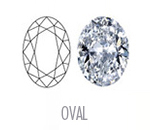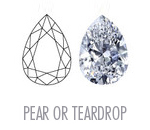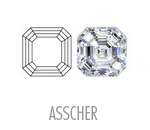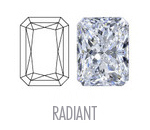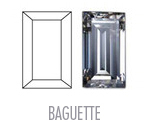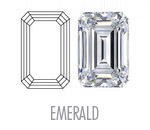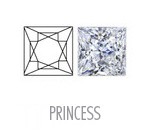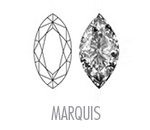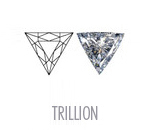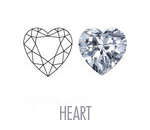The Anatomy of a Diamond
Characteristics of Diamond
GIA standardized the grading of diamonds in 1953 by creating the grading system we know of today and accepted all over the world. It started printing the GIA reports in 1955 based on the four Cs.
Every diamond is unique with its own characteristics. Diamonds you are going to buy today started in the making deep in the Earth long time ago. Heat, pressure and millions to billions of years is what has turned carbon into the beautiful and fascinating diamond. The rough diamond comes to the surface by volcanoes and by man excavating them. Only 15% of rough diamonds will be of gem quality the rest is used for industrial purposes.
The price of a diamond is determined by the grade given on each of the four Cs; Cut, Color, Clarity and Carat weight.
Cut
The rough diamond found in nature lacks luster and shine. It is the expert and skilled cutter that uncovers the true beauty of the diamond. A diamond cut with ideal proportions will have maximum brilliance. To cut a diamond of ideal proportions will result in a greater loss of weight from the rough. That is why many cutters choose to produce a larger diamond over producing a slightly smaller diamond with better cut. It is the choice of size over quality. The ideal proportions in the relationship between the table, crown and pavilion is what produces the most scintillation due to the optimal refraction and reflection of light. As seen in the diagram, in a shallow cut diamond light will refract downward and in case of a deep cut diamond light will refract sideways. In the ideal cut diamond, the light rays will all bounce back out through the table and the crown thus giving it the scintillation thus brilliance. Also important in grading of Cut is symmetry and polish. The closer a diamond is cut with optimal or ideal proportions the more it will be expensive.
Color
The color of the diamond ranges from D, which is the whitest or colorless to Z having most color.
Color is the first think one sees, therefore has great importance. The less color a diamond has the whiter it is, whiter diamonds are more rare therefore more expensive.
Most of the time it is hard for the naked untrained eye to see the color difference within its colorless, near colorless, faint yellow, and light yellow grouping. However, if placed next to each other a colorless diamond will be easily identified when place next to an I or J color.
Some diamonds fluoresce under ultra violet light that may range from faint to strong. Diamonds with florescence will appear oily or cloudy making them undesirable.
Clarity
Many factors contribute to each diamond’s characteristics. Internally flawless diamonds are very rare therefore more expensive. Most diamonds have inclusions ranging from microscopic to visible to the naked eye. It is the quantity, size, type and location of the inclusions that will give it the clarity grade from VVS to I. Flaws can be one or a combination of black or white crystals, feathers, needles, pinpoints, twinning wisps, cavity, indented natural, chips and clouds. Although most imperfections are internal, some are found on the surface and are called blemishes. Any size imperfection that is located in the middle of the diamond will interfere with the refraction and reflection of light thus affecting its brilliance and scintillation.
Carat
Carat is the weight with which a diamond is measured. There are 100 points in a carat. This C is easiest to measure and grade. The larger the diamond the more expensive it will be.
All four Cs contribute to the price of the diamond. To be able to make a fair comparison one has to compare each line on the certifications issued from the same lab.
Diamond and Gemstone Shapes
Diamond and Gemstone Shapes
It is very important to make an educated decision when making an investment like purchasing a diamond. In order to ensure our customers are educated and fully informed about what they are getting when purchasing a diamond from Jewelry Exchange Co., all of our diamonds are professionally graded by the most reputable gemological labs. Each lab has its own grading system and standards. We believe GIA certified diamonds are graded with the strictest standards and greatest accuracy of any gem lab, we also carry some EGL USA certified diamonds as well for those who may prefer an EGL certificate. It is very important when you are comparing diamonds that you are comparing ones that have very similar certificate results and from the same gemological lab.
Precious Metals
Gold
Gold is a precious metal found in nature in its purest form of 24K. In that form, it is too soft and malleable to be used in jewelry. Alloys added to gold reduce it to the desired Karat to make it stronger as in 18K and 14K, which is widely used to create fine jewelry. 18K consists of 75% gold, 14K is 58% gold. Alloys consist of copper, silver and palladium. Mostly, copper is added for yellow gold, palladium and other white metals are added to create white gold. Jewelry made in white gold is normally Rhodium plated to give it the very white color.
Platinum
Platinum used in jewelry is 90% to 95% pure. Since it is a white metal and the 5%-10 % alloy is Iridium which is also a white metal , it will always stay white. Being a dense metal makes it more durable. Although Platinum scratches or dings, it does not lose from its integrity does not “wear off”. Three factors makes platinum jewelry slightly more expensive than gold. Platinum is used almost in its purest form. Being a dense metal makes it heavier, the same jewelry will weigh 70% more than made in gold. Due to its density it makes it a harder metal; more labor intensive to work with than gold.






